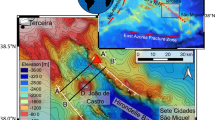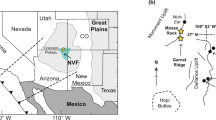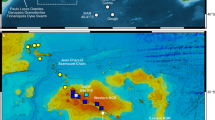Abstract
Mount Etna, the largest volcano in Europe, lies close to the subduction-related Aeolian magmatic arc but shows no trace of subducted material in its magmas. Mount Etna is also situated on continental crust yet shows oceanic basalt affinities1,2,3, with isotopic ratios of helium and carbon suggesting that it is fed by the same type of mantle source as are mid-ocean ridge basalts4,5. Here we propose that although this giant volcano is not subduction-related—in the sense that it is not part of the magmatic arc—its formation is strongly related to the nearby subduction process. Based on a three-dimensional model of the tectonic plates in this region, we propose that the voluminous melting under Mount Etna results from ‘suction’ of asthenospheric material from under the neighbouring African plate. Such lateral flow is expected when descending slabs migrate backwards in the mantle (rollback) leaving low-pressure regions behind6,7 them. This was previously identified at the northern end of the Tonga arc (southwest Pacific Ocean) where such flow feeds arc8 or backarc9 magmatism. Here we show that in the south Tyrrhenian subduction zone, slab rollback pulls asthenospheric material much farther along the plate contact, reaching the base of the crust in the forearc region. This explains the voluminous melting under Mount Etna and also the recent uplift of the forearc region (the Calabrian peninsula)10.
This is a preview of subscription content, access via your institution
Access options
Subscribe to this journal
Receive 51 print issues and online access
$199.00 per year
only $3.90 per issue
Buy this article
- Purchase on Springer Link
- Instant access to full article PDF
Prices may be subject to local taxes which are calculated during checkout



Similar content being viewed by others
References
Barberi,F. et al. Evolution of a section of the African-Europe plate boundary: paleomagnetic and volcanological evidence from Sicily. Earth Planet. Sci. Lett. 21, 269–276 (1974).
Condomines,M., Tanguy,J. C., Kieffer,G. & Allegre,C. J. Magmatic evolution of a volcano studied by 230Th 238U disequilibrium and trace elements systematics: The Etna case. Geochim. Cosmochim. Acta 46, 1397–1416 (1982).
Tanguy,J. C. Tholeiitic basalt magmatism of Mount Etna and its relations with alkaline series. Contrib. Mineral. Petrol. 66, 51–67 (1978).
Allard,P. et al. Mantle-derived helium and carbon in groundwater and gases of Mount Etna, Italy. Earth Planet. Sci. Lett. 148, 501–516 (1997).
Allard,P. et al. Eruptive and diffuse emissions of CO2 from Mount Etna. Nature 351, 387–391 (1991).
Nur,A., Dvorkin,J., Mavko,G. & Ben Avraham,Z. Speculations on the origin and fate of backarc basins. Ann. Geofis. 36, 155–163 (1991).
Dvorkin,J., Nur,A., Mavko,G. & Ben Avraham,Z. Narrow subducting slabs and the origin of backarc basins. Tectonophysics 227, 63–79 (1993).
Wendt,J. I., Regelous,M., Collerson,K. D. & Ewart,A. Evidence for a contribution from two mantle plumes to the island arc lavas from northern Tonga. Geology 25, 611–614 (1997).
Turner,S. & Howkesworth,C. Using geochemistry to map mantle flow beneath the Lau basin. Geology 26, 1019–1022 (1998).
Gvirtzman,Z. & Nur,A. Plate detachment, asthenosphere upwelling, and topography across subduction zones. Geology 27, 563–566.
Monaco,C., Tapponnier,P., Tortorici,L. & Gillot,P. Y. Late quaternary slip rates on the Acireale-Piedimonte normal fault and tectonic origin of Mt. Etna (Sicily). Earth Planet. Sci. Lett. 147, 125–139 (1997).
Frepoli,A., Selavagi,G., Chiarabba,C. & Amoto,A. State of stress in southern Tyrrhenian subduction zone from fault-plane solutions. Geophys. J. Int. 125, 879–891 (1996).
Lachenbruch,A. H. & Morgan,P. Continental extension, magmatism and elevation: Formal relations and rules of thumb. Tectonophysics 174, 39–62 (1990).
Jones,H. J., Unruh,J. R. & Sonder,L. J. The role of gravitational potential energy in active deformation in the southwestern United States. Nature 381, 37–41 (1996).
Steinmetz,L., Ferrucci,F., Hirn,C. A., Moreli,C. & Nicholich,R. A 550 km long Moho traverse in the Tyrrhenian Sea from O.B.S. recorded PN waves. Geophys. Res. Lett. 10, 428–431 (1983).
Scarascia,S., Lozej,A. & Cassinis,R. Crustal structures of the Ligurain, Tyrrhenian, and Ionian seas and adjacent onshore areas interpreted from wide-angle seismic profiles. Boll. Geofis. Teor. Applic. 36, 5–19 (1994).
Moreli,C. Current knowledge on the crustal properties of Italy. Ann. Geofis. 37, 1113–1130 (1997).
Gvirtzman,Z. & Nur,A. Residual topography, lithospheric structure and sunken slabs in the central Mediterranean. Earth Planet. Sci. Lett. (submitted).
Kastens,K. et al. ODP Leg 107 in the Tyrrhenian Sea: Insight into passive and backarc basin evolution. Geol. Soc. Am. Bull. 100, 1140–1156 (1988).
Westaway,R. Quaternary uplift of south Italy. J. Geophys. Res. 98, 21741–21772 (1993).
Mazzuoli,R., Tortorici,L. & Ventura,G. Oblique rifting in Salina, Lipari, and Vulcano islands (Aeolian islands, southern Italy). Terra Nova 7, 444–452 (1995).
Isacks,B. L. & Barazangi,M. in Island Arcs, Deep Sea Trenches, and Backarc Basins (eds Talawani, M. and Pitman, W. C.) 99–114 (Maurice Ewing Ser. 1, American Geophysical Union, Washington DC, 1977).
Bijwaad,H., Spakman,W. & Engdahl,E. R. Closing the gap between regional and global travel time tomography. J. Geophys. Res. 103, 30055–30078 (1998).
Carminati,E., Wortel,M. J. R., Spakman,W. & Sabadina,R. The role of slab detachment processes in the opening of the western-central Mediterranean basin: some geological and geophysical evidence. Earth Planet. Sci. Lett. 160, 651–665 (1998).
Mele,G. High frequency wave propagation from mantle earthquakes in the Tyrrhenian Sea: New constraints for the geometry of the south Tyrrhenian subduction zone. Geophys. Res. Lett. 25, 2877–2880 (1998).
Amato,A., Alessandrini,B., Cimini,G. B., Frepoli,A. & Selvaggi,G. Active and remnant subducted slabs beneath Italy: evidence from seismic tomography and seismicity. Ann. Geofis. 36, 201–214 (1993).
Wortel,M. J. R. & Spakman,W. Structure and dynamics of subducted lithosphere in the Mediterranean region. Proc. Koninklijke Ned. Acad. Wetensch. 95, 325–347 (1992).
Spakman,W., van de Lee,S. & van der Hilst,R. Travel time tomography of the European-Mediterranean mantle down to 1400 km. Phys. Earth Planet. Inter. 79, 3–74 (1993).
Author information
Authors and Affiliations
Corresponding author
Rights and permissions
About this article
Cite this article
Gvirtzman, Z., Nur, A. The formation of Mount Etna as the consequence of slab rollback. Nature 401, 782–785 (1999). https://doi.org/10.1038/44555
Received:
Accepted:
Issue Date:
DOI: https://doi.org/10.1038/44555
This article is cited by
-
Magma budget, plutonic growth and lateral spreading at Mt. Etna
Communications Earth & Environment (2024)
-
Variations in the crustal structure and strength of plate coupling along the Ryukyu subduction zone
Geoscience Letters (2023)
-
Seismic anisotropy to investigate lithospheric-scale tectonic structures and mantle dynamics in southern Italy
Scientific Reports (2023)
-
Seismic risk assessment of a large metropolitan area by means of simulated earthquakes
Natural Hazards (2023)
-
New insights on the active degassing system of the Lipari–Vulcano complex (South Italy) inferred from Local Earthquake Tomography
Scientific Reports (2022)
Comments
By submitting a comment you agree to abide by our Terms and Community Guidelines. If you find something abusive or that does not comply with our terms or guidelines please flag it as inappropriate.



